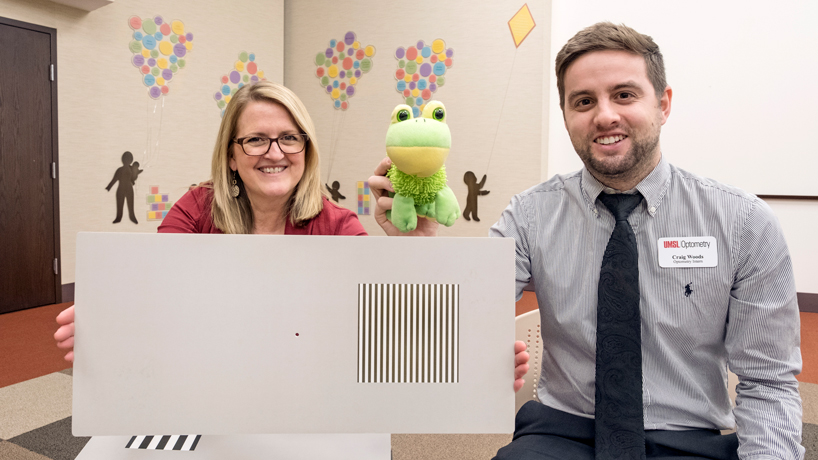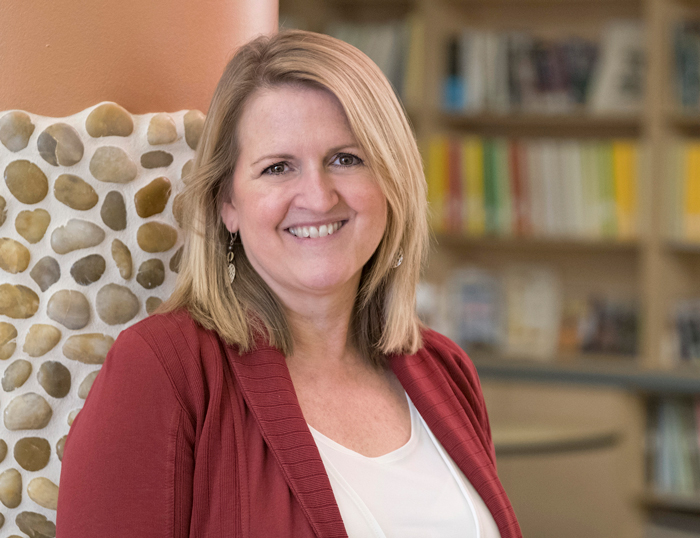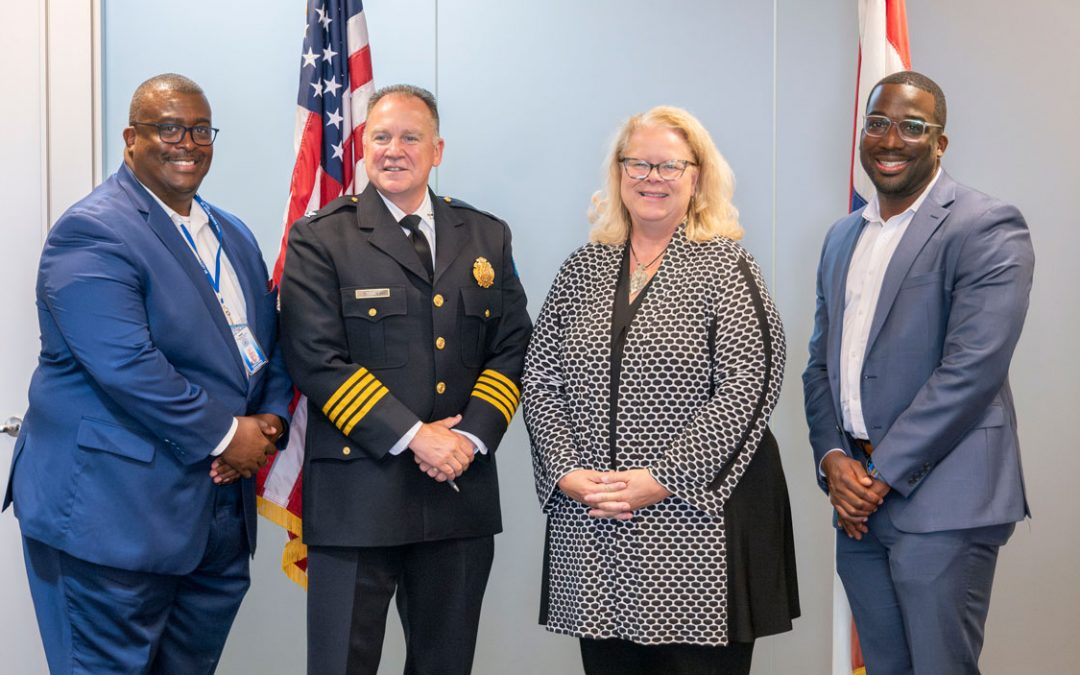
UMSL Associate Clinical Professor and Doctor of Optometry Katie Boland (at left) and student Craig Woods pose with a teller card – one item the doctors use to help assess children’s vision at the Delta Gamma Center for Children with Visual Impairments. “The thought behind it,” Boland explains, “is that if the child can see, they will look to the side of the card with the pattern rather than the blank grey side.” (Photos by August Jennewein)
Ask any adult to think back to their last vision screening, and chances are they won’t mention an eye doctor who got down on the floor and played with toys with them or followed them patiently as they roamed carefree around the room.
But ask the children at the Delta Gamma Center for Children with Visual Impairments, who get to see University of Missouri–St. Louis Associate Clinical Professor and Doctor of Optometry Katie Boland, and they just might – when they get a little older, that is.
Every Thursday afternoon, thanks to a partnership between UMSL and the center which began in January 2014, children from 6 months to 3 years of age have a chance to experience low vision evaluations with Boland and the fourth-year optometry students who accompany her.
As a result, the children’s parents also have the opportunity to get their often-pressing questions answered.
According to Lisa Rohr, the center’s director of early intervention services, addressing those fundamental parental concerns is a vital component of Delta Gamma’s mission. It is also a large part of the reasoning behind their partnering with UMSL in the first place.
What Boland brings to the center, Rohr says, is not only medical expertise but the patience, diligence and communication skills necessary to assist parents who are just beginning to learn about visual impairment, as well as what it may or may not mean for their very young children.
“It can be challenging to get accurate information about a child’s vision in a short office visit,” Rohr explains, “but it is even more challenging for infants and toddlers who may not be able to communicate and may have additional disabilities. That is the population that Dr. Boland serves.”
It’s a population the UMSL optometrist is quite comfortable with.

Boland, who is also a UMSL optometry alumna, says she returned to school to pursue optometry in her mid-30s, thanks in part to the experience of allowing a friend who was already going through the program to practice eye exams on her. This piqued her own interest, she began taking science classes and, before long, she was enrolled in the program herself.
“Before I went to UMSL myself for optometry school in my 30s,” Boland explains with a smile, “I had my kids, and I babysat out of my home. I also have 32 nieces and nephews, so I’m always around children. I love them.”
Another thing she loves? The family-centered, communicative approach that she and the staff members at the center get to apply to their work.
“When I first started work with Delta Gamma, I had this idea that I would just go in and find out what the children’s vision is,” explains Boland. “But when I got there, I realized it’s much more involved and informational than that. It’s about talking with the parents and making them understand the language of vision in general and low vision in particular as it pertains to their child. It’s about helping them understand how the way another child can’t see is different from how their child can’t see, and this helps them to be able to go forward and work with other professionals on behalf of their child. I really like that aspect of it.”
Working with the children and their parents, Boland adds, is also a great learning experience for the College of Optometry students she brings with her each week to the center.
“In primary care clinic rotations, the optometry students working with pediatric patients may be able to use a children’s chart, or the patients might be able to sit still long enough that they can gather some information,” Boland explains. “But the children at Delta Gamma are young enough that we don’t really know what they’re seeing. They don’t yet have the words to be able to tell us. It’s beneficial for the optometry students to learn different ways of gathering that same information in a roundabout way – like putting the pieces of a puzzle together and interpreting the information backwards.”
One more benefit for the optometrists in training, according to Molly Gorder, a fourth-year student who accompanied Boland during one of her program’s clinical rotations, is the chance to work with other service providers to benefit the patients.
“We worked closely with specialists such as individuals who provide orientation and mobility services,” Gorder offered as one example. “This was so important because we know that patients are best cared for when professionals and patients are working together as a team, and I was able to see that the Delta Gamma Center does this very well.”
The center’s staff is eager to give some of that credit right back to Boland and her creative dedication.
“It’s a pleasure working with Dr. Boland,” Rohr says. “She is creative in her approach and willing to do whatever it takes to get a meaningful response from each and every child she sees. Her passion for her job and her sincere concern for each of her patients make her an ideal partner.”















